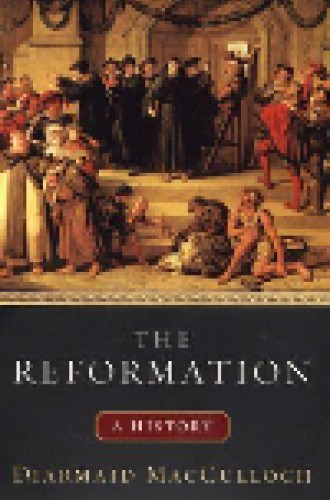The Reformation
Of the writing (and publishing) of histories of the Protestant Reformation there is no end: almost a dozen Reformation histories have been published in English within the past decade or so, suggesting that the subject continues to fascinate. While these histories differ in insight, eloquence and emphasis, they all till the same ground—the religious changes in Europe between roughly 1517 and 1600. Some pretend to a lengthier chronological scope (sometimes as broad as 1300 to 1700), but such declarations notwithstanding, they, too, concentrate on what happened between Martin Luther’s posting of his 95 Theses in 1517 and the end of the century, when Protestantism was firmly established in many European countries.
Diarmaid MacCulloch, a specialist in Tudor history with a significant biography of Thomas Cranmer to his credit, now joins this noble tradition. His striking narrative is the weightiest of the available Reformation histories, in both senses of the word. MacCulloch is an elegant stylist, and part of the virtue of his book lies in the charm, wit and competence with which he tells his story. His preface closes with the programmatic announcement that the book is meant for a wider audience (that, of course, being the hope of all authors!), and his exquisite, though at times somewhat sarcastic, style helps make it so.
MacCulloch begins his story in 1490 (when European warfare shifted to Italy) and ends it in 1700. He lays the groundwork for the real story, which begins with Luther, by beginning in the traditional way, with a summary of the state of church and society in the years preceding Luther. He has no new interpretative scheme, but his conversancy with secondary literature is impressive, and the extensive attention he pays to events in England is understandable, given his scholarly expertise. Not always on target with facts or interpretation, MacCulloch nevertheless gives us the most readable and competent history of the actual Reformation period available.
Unfortunately, the book’s time scheme suggests that the 210 years between 1490 and 1700 were a cohesive historical period. The 17th century can indeed be characterized as a time of Reformation in England, but the Continental story is far less amenable to being subsumed under that category. Though there is reform in Pietism toward the end of the century, it’s not a label one would use for the century as a whole, unless in the traditional sense of the Catholic Counter Reformation or by focusing on the “confessionalization” dynamic that followed the Reformation proper. But these “reform” impulses receive little attention in the book.
When MacCulloch gets to the 17th century, detailed exposition gives way to swift generalizations. He gives neither a history of Christianity nor a history of reform during that time. Little is said about those who began to offer a radically new Christian perspective; about the beginnings of biblical criticism; or about the impact of Herbert of Cherbury and the first wave of what was subsequently called Christian Deism. These radical challenges to the traditional Christian self-understanding had profound consequence for the story of Christianity.
The third part of the book seeks to paint a picture of what it was like to be a Protestant during the time. Here MacCulloch ventures something quite commendable and brilliant—the juxtaposition of chronological narrative and thematic reflection. Unfortunately, his choice of topics is unsatisfactory: “Changing Times: Fighting Antichrist,” “The Fear of Sodomy” and “Wars of Reformation,” to cite a few. The choices—sex and sexuality receive, in this reviewer’s nonprudish judgment, a surprising amount of attention—do not appear to encompass the real world of common Protestants. Trying to cover two tumultuous centuries in this way is a daunting enterprise, and the attempt is only partially successful.
Some admirable generalizations about the 18th, 19th and even the 20th century are clouded by surprising biases. MacCulloch notes that the “Reformation and Counter-reformation shed much blood and shortened or ruined countless lives”; that “Luther’s writing of 1543 was a blueprint for the Nazis’ Kristallnacht”; that the “fiasco” of Pope Paul IV’s encyclical Humanae vitae meant that “the only alternatives are either to cleave to the pattern of life and assumptions set out in the Bible, or to say that in this, as in much else, the Bible is simply wrong.” He observes that “it is always unpredictable as to which beliefs from the Reformation past will suddenly remerge. So in the 1980s the United States experienced the presidency of Ronald Reagan, who believed in the Bible’s predictions of an imminent arrival of the apocalyptic time as [much as] any of the Protestant savants of Interregnum England.” Really?
MacCulloch seems to have sought to put a distance between himself and the historical movement he describes. Of course, Reformation historiography through the centuries includes both the movement’s ardent admirers and its detractors. Catholic historians and theologians have never been fond of the Reformation, and the recent Luther biography by Richard Marius labeled the reformer a “tragedy” of German history—a judgment quite contrary to the hero worship of the recent Luther film. One regrets that the reader’s enjoyment of the work of a learned and eloquent scholar is a bit marred by the generalizations which conclude his book.





